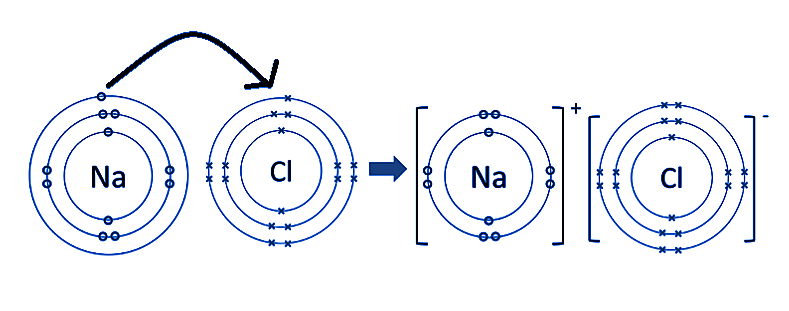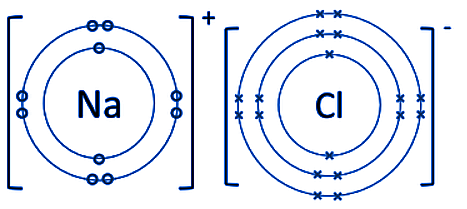The number of electrons in the outermost shell of an atom determines its chemical characteristics. We visualize valence electrons using Lewis dot structures to locate stable electron configurations. In order to attain stability in any atom (like noble gases), the majority of atoms often lose or gain electrons.
In this article, we will learn how to draw the Lewis dot structure of Sodium Chloride stepwise.
1. What is a Lewis Dot Structure?
A Lewis structure is a type of diagram used to represent the electron configuration of a molecule or ion. It is named after Gilbert Lewis, who first proposed it in 1916. The structure consists of a skeletal structure of the molecule, with atoms represented by their chemical symbols and electrons represented by dots.
The dots are placed around the chemical symbols to show the distribution of electrons in the molecule. The number of dots around an atom represents the number of electrons that are available for bonding with other atoms in the molecule. The Lewis structure is useful for predicting the geometric shape of a molecule and the chemical properties of its bonds.

2. How to Draw Lewis Dot Structure?
We use an element’s symbol to represent an electron dot structure. The valence electrons are represented by dots that are added clockwise to an element’s chemical symbol.
There can be a maximum of eight dots. This is to ensure that the octet rule may be followed, which only allows for a maximum of eight valence electrons.
For a Lewis dot structure, the octet rule is important.
According to the octet rule, atoms tend to gain, lose, or share valence electrons in order to achieve a noble gas configuration, which gives the atom stability. The octet rule only takes into account the s and p electrons; it ignores the d and f electrons.
The steps needed to draw them are:
Step 1: Count all the Valence Electrons
The individual valence electrons of each atom are added to determine the total number of valence electrons in the compound’s molecule.
Step 2: Locate the Central Atom
The central atom of the molecule or ion is chosen because it has the lowest electronegative charge. All of the other atoms or ions will be bound to the core metal atom. In a particular molecule, the central atom to be selected should have the least subscripts.
Step 3: Draw every single bond to the main metal atom.
Two valence electrons, one from each atom, are represented by a single bond, helping to form the bond. A single bond is represented by a line.
Step 4: Calculation of lone Pairs of Electrons
An atom in a molecule can have zero, one or more lone pairs. Each atom in the molecule is assigned a pair of lone electrons. This can be done as-
If t is the total number of electrons and n is the number of single bonds, t – 2n electrons remain to be placed. These should be placed as lone pairs: one pair of dots for each available pair of electrons. Lone pairs should be placed on outer atoms first, until each outer atom has eight electrons in bonding pairs and lone pairs. Additional lone pairs can then be placed on the central atom. The most electronegative atoms are generally assigned to the lone pairs first.
Step 5: If no atom has an octet configuration after the lone pairs have been assigned, a double or triple bond must be drawn to fulfill the octet valency of each atom.
In order to comply with the octet rule for two atoms, a lone pair can be changed into a bond pair if necessary.
Note: The electrons that do not belong to the outermost shell are omitted while drawing Lewis dot structures and only the valence electrons are taken into consideration.
3. Lewis Dot structure of Sodium Chloride
Lewis structure for NaCl consists of two elements sodium (Na) metal and chlorine (Cl) atom. There is an ionic bond between sodium and chlorine, one atom donates an electron and the other accepts it. As a result, each atom acquires a charge.
Chlorine has seven valence electrons and sodium has one valence electron. Therefore, chlorine gains one electron whereas sodium loses one in order for each atom to complete an octet.
As a result, sodium acquires a positive charge, and chlorine has a negative charge.
Steps to draw Lewis Structure of Sodium Chloride
Step 1: Count all the Valence Electrons
Chlorine = 7valence electrons
Sodium = 1 valence electron.
Total valence electrons = 8

Step 2: Locate the Central Atom
Since this is a diatomic molecule with only two atoms, selecting the central atom with the lowest electronegativity is not required.
Sodium(Na) is the metal that donates one electron away and forms a Na+ ion.
Chlorine is a nonmetal that will accept one electron and forms a Cl– ion.

The chlorine ion receives 1 electron, which are shown as dots in its outermost shell in the upper NaCl Lewis structure, and thereby attained stability by completing the octet.
While the sodium atom only had one valence electron in its outermost shell and losing it lead to attaining stability by completing the octet.
As a result, sodium and chlorine ions both have fully filled valence shells and noble gas configurations.
The sodium chloride compound’s lewis structure is now complete.

We enclose the sodium and chlorine atoms in a bracket to indicate their positive and negative charges in the NaCl lewis dot structure.
Key Takeaways
- In the Lewis electron dot structure, the valence electrons around an atomic symbol are shown as dots.
- Lewis electron dot diagrams for ions show either more or fewer dots (depending on the kind of cation or anion) than those for the corresponding atom.
- The sodium atom completes its octet by transferring one electron to the chlorine atom in the NaCl lewis dot structure.
FAQs
How many valence electrons does sodium have in its Lewis dot structure?
Sodium has 1 valence electron in its Lewis dot structure.
How many valence electrons does chlorine have in its Lewis dot structure?
Chlorine has 7 valence electrons in its Lewis dot structure.
How are the valence electrons arranged in the Lewis dot structure of sodium chloride?
In the Lewis dot structure of sodium chloride, the valence electron from sodium forms a covalent bond with one of the valence electrons from chlorine. The remaining valence electrons from both sodium and chlorine are arranged around the atoms as lone pairs.
How many covalent bonds are formed in the Lewis dot structure of sodium chloride?
In the Lewis dot structure of sodium chloride, there is no covalent bond formed.
What is the chemical formula of the compound represented by the Lewis dot structure of sodium chloride?
The chemical formula of the compound represented by the Lewis dot structure of sodium chloride is NaCl.
